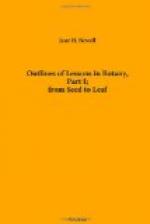The charred part of the wood is charcoal, which is one form of carbon. Our ordinary charcoal is made by driving off all the gases from wood, by burning it under cover where only a little air can reach it. The volatile gases burn more readily than the carbon, and are the first substances to be driven off, so that the carbon is left behind nearly pure. In the same way we have driven off all the gases from the half-burned match and left the carbon. The teacher should have a piece of charcoal to show the pupils. It still retains all the markings of the wood.
If the combustion is continued, the carbon also unites with the oxygen of the air, till it is all converted into carbonic acid gas. This was the case with the match where we left the glowing spark. The gray ash that was left behind is the mineral matter contained in the wood.
(7) We can show that this gas is formed by pouring lime water into a bottle in which a candle has been burned as in (2). The water becomes milky from a fine white powder formed by the union of the carbonic acid gas with the lime, forming carbonate of lime. This is a chemical test.
The wood of the match is plainly of vegetable origin; so also is the charcoal, which is nearly pure carbon. Coal is also carbon, the remains of ancient forests, from which the gases have been slowly driven off by heat and pressure. All the common fuels are composed principally of carbon and hydrogen. When these elements unite with oxygen, carbonic acid gas and water are formed.[1]
[Footnote 1: [Transcriber’s Note: This note is missing from original text.]]
(8) The same products are formed by respiration. We breathe out carbonic acid gas and water from our lungs. Breathe on a cold glass. It is bedewed exactly as it is by the candle flame. Breathe through a bit of glass tubing into a bottle of lime water. It becomes milky, showing the presence of carbonic acid gas. Why is this?
Every act or thought is accompanied by a consumption of material in the body, which thus becomes unfit for further use. These waste substances, composed chiefly of carbon and hydrogen, unite with oxygen breathed in from the air, forming carbonic acid gas and water, which are breathed out of the system. The action is a process of slow combustion, and it is principally by the heat thus evolved that the body is kept warm. As we are thus constantly taking oxygen from the air, a close room becomes unfit to live in and a supply of fresh air is indispensable. The cycle of changes is completed by the action of plants, which take in carbonic acid gas, use the carbon, and return most of the oxygen to the atmosphere.
APPARATUS FOR EXPERIMENTS.[1]
[Footnote 1: The glass apparatus required, including an alcohol lamp, may be obtained for one dollar by sending to the Educational Supply Co., No. 6 Hamilton Place, Boston.]
Two small wide-mouthed bottles. A narrow-necked bottle. A glass funnel. A bit of bent glass-tubing. A bit of straight glass-tubing. A flat piece of glass. A test-tube, with jet. An alcohol lamp. A bent wire with taper. A card. A slip of a plant. A dish and pitcher of water. Beeswax or paraffine. Shavings. Lime water. Matches.




